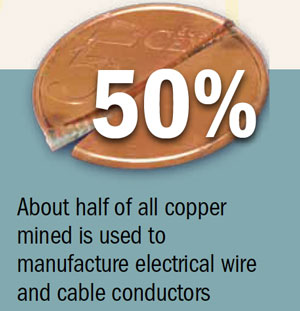Picture This
Minerals of the Future
Finance & Development, September 2013, Vol. 50, No. 3
A secure, green, and innovation-filled future awaits us, but only with the help of rocks buried deep in the ground
New forms of energy, more mouths to feed, and exciting innovations in technology—all are part of the future, and all will depend on minerals we extract from the earth. Some of these minerals are well known for their more common uses—while others lack widespread notoriety.
CLEANER AND GREENER
Silver
Silver is known for its use in coins and jewelry, but it will be important in the future because it’s also needed to harness solar energy. Silver is the primary ingredient in solar panels used to catch the sun’s rays and transform them into energy.

But it doesn’t stop there. Silver ions are starting to be added to water purification systems used in hospitals, community water systems, and pools, replacing chlorine as the element of choice for filtration. Ongoing research suggests that silver could be instrumental in addressing the issue of clean drinking water across the planet.
Copper

Another mineral well known for its use in coins is copper, but its properties make it extremely useful as a conductor of heat and electricity, so for many years it has remained the preferred compound in most electrical wiring.
Copper is vital to the electrical grounding system for wind turbine farms. Given frequent lightning strikes, the grounding system is needed to channel lightning to the ground to prevent it from damaging the turbines. In all the years leading up to 2011, 714 kilotons of copper had been used in wind energy systems—and, in 2011 alone, 120 kilotons were used, with more expected to be needed in the coming years.
FOOD SECURITY
Potash

Potash is the common name for naturally occurring water-soluble potassium salts, the most common of which is potassium chloride.
Potash is used in many countries as a fertilizer to grow rice, wheat, sugar, corn, soybeans, and various fruits and vegetables. In India, for example, 70 percent of soils have low to medium potassium content, and potash must be added so crops will produce enough food to feed the growing population.
With the world’s population expected to reach 9.5 billion by 2050, arable land per person will decrease, and more crops will need to be grown on less land—and, at the same time, feed more people.
TECHNOLOGICAL INNOVATION
Rare earths
Rare earths are a set of 17 related metals, currently mined predominantly in China.
Rare earths are needed for everything from televisions and smartphones to power generators for wind turbines. They have unique chemical properties that allow them to combine with other elements to produce results that neither element could on its own.
Lanthanum is the second most abundant rare-earth element, and every Prius hybrid car on the road carries 10 pounds of this element in its nickel-lanthanum battery.

Another rare earth, europium, first brought the color red to color televisions back in the 1960s, and it now looks to be the missing ingredient for white LED lighting to illuminate homes and offices as naturally as sunlight—and more energy efficiently than incandescent and fluorescent lighting.


